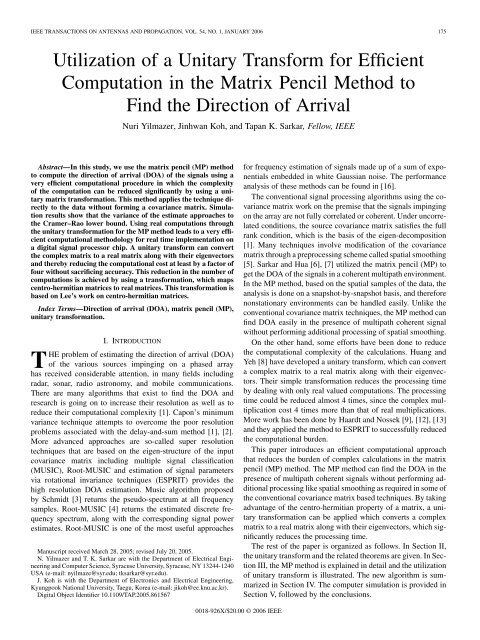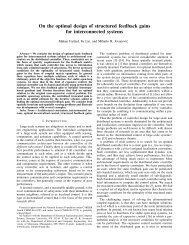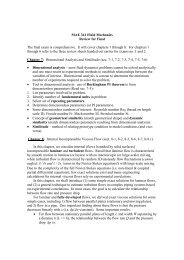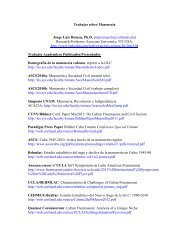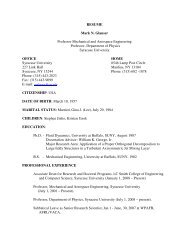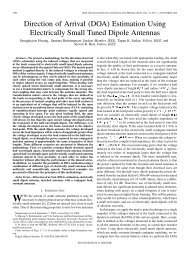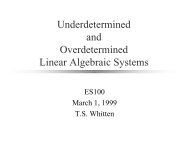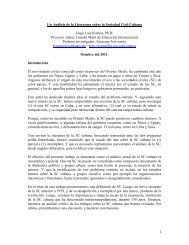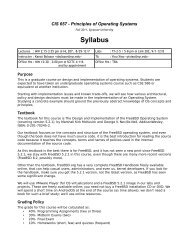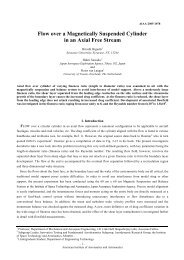Utilization of a Unitary Transform for Efficient Computation in the ...
Utilization of a Unitary Transform for Efficient Computation in the ...
Utilization of a Unitary Transform for Efficient Computation in the ...
Create successful ePaper yourself
Turn your PDF publications into a flip-book with our unique Google optimized e-Paper software.
IEEE TRANSACTIONS ON ANTENNAS AND PROPAGATION, VOL. 54, NO. 1, JANUARY 2006 175<br />
<strong>Utilization</strong> <strong>of</strong> a <strong>Unitary</strong> <strong>Trans<strong>for</strong>m</strong> <strong>for</strong> <strong>Efficient</strong><br />
<strong>Computation</strong> <strong>in</strong> <strong>the</strong> Matrix Pencil Method to<br />
F<strong>in</strong>d <strong>the</strong> Direction <strong>of</strong> Arrival<br />
Nuri Yilmazer, J<strong>in</strong>hwan Koh, and Tapan K. Sarkar, Fellow, IEEE<br />
Abstract—In this study, we use <strong>the</strong> matrix pencil (MP) method<br />
to compute <strong>the</strong> direction <strong>of</strong> arrival (DOA) <strong>of</strong> <strong>the</strong> signals us<strong>in</strong>g a<br />
very efficient computational procedure <strong>in</strong> which <strong>the</strong> complexity<br />
<strong>of</strong> <strong>the</strong> computation can be reduced significantly by us<strong>in</strong>g a unitary<br />
matrix trans<strong>for</strong>mation. This method applies <strong>the</strong> technique directly<br />
to <strong>the</strong> data without <strong>for</strong>m<strong>in</strong>g a covariance matrix. Simulation<br />
results show that <strong>the</strong> variance <strong>of</strong> <strong>the</strong> estimate approaches to<br />
<strong>the</strong> Cramer–Rao lower bound. Us<strong>in</strong>g real computations through<br />
<strong>the</strong> unitary trans<strong>for</strong>mation <strong>for</strong> <strong>the</strong> MP method leads to a very efficient<br />
computational methodology <strong>for</strong> real time implementation on<br />
a digital signal processor chip. A unitary trans<strong>for</strong>m can convert<br />
<strong>the</strong> complex matrix to a real matrix along with <strong>the</strong>ir eigenvectors<br />
and <strong>the</strong>reby reduc<strong>in</strong>g <strong>the</strong> computational cost at least by a factor <strong>of</strong><br />
four without sacrific<strong>in</strong>g accuracy. This reduction <strong>in</strong> <strong>the</strong> number <strong>of</strong><br />
computations is achieved by us<strong>in</strong>g a trans<strong>for</strong>mation, which maps<br />
centro-hermitian matrices to real matrices. This trans<strong>for</strong>mation is<br />
based on Lee’s work on centro-hermitian matrices.<br />
Index Terms—Direction <strong>of</strong> arrival (DOA), matrix pencil (MP),<br />
unitary trans<strong>for</strong>mation.<br />
I. INTRODUCTION<br />
THE problem <strong>of</strong> estimat<strong>in</strong>g <strong>the</strong> direction <strong>of</strong> arrival (DOA)<br />
<strong>of</strong> <strong>the</strong> various sources imp<strong>in</strong>g<strong>in</strong>g on a phased array<br />
has received considerable attention, <strong>in</strong> many fields <strong>in</strong>clud<strong>in</strong>g<br />
radar, sonar, radio astronomy, and mobile communications.<br />
There are many algorithms that exist to f<strong>in</strong>d <strong>the</strong> DOA and<br />
research is go<strong>in</strong>g on to <strong>in</strong>crease <strong>the</strong>ir resolution as well as to<br />
reduce <strong>the</strong>ir computational complexity [1]. Capon’s m<strong>in</strong>imum<br />
variance technique attempts to overcome <strong>the</strong> poor resolution<br />
problems associated with <strong>the</strong> delay-and-sum method [1], [2].<br />
More advanced approaches are so-called super resolution<br />
techniques that are based on <strong>the</strong> eigen-structure <strong>of</strong> <strong>the</strong> <strong>in</strong>put<br />
covariance matrix <strong>in</strong>clud<strong>in</strong>g multiple signal classification<br />
(MUSIC), Root-MUSIC and estimation <strong>of</strong> signal parameters<br />
via rotational <strong>in</strong>variance techniques (ESPRIT) provides <strong>the</strong><br />
high resolution DOA estimation. Music algorithm proposed<br />
by Schmidt [3] returns <strong>the</strong> pseudo-spectrum at all frequency<br />
samples. Root-MUSIC [4] returns <strong>the</strong> estimated discrete frequency<br />
spectrum, along with <strong>the</strong> correspond<strong>in</strong>g signal power<br />
estimates. Root-MUSIC is one <strong>of</strong> <strong>the</strong> most useful approaches<br />
Manuscript received March 28, 2005; revised July 20, 2005.<br />
N. Yilmazer and T. K. Sarkar are with <strong>the</strong> Department <strong>of</strong> Electrical Eng<strong>in</strong>eer<strong>in</strong>g<br />
and Computer Science, Syracuse University, Syracuse, NY 13244-1240<br />
USA (e-mail: nyilmaze@syr.edu; tksarkar@syr.edu).<br />
J. Koh is with <strong>the</strong> Department <strong>of</strong> Electronics and Electrical Eng<strong>in</strong>eer<strong>in</strong>g,<br />
Kyungpook National University, Taegu, Korea (e-mail: jikoh@ee.knu.ac.kr).<br />
Digital Object Identifier 10.1109/TAP.2005.861567<br />
<strong>for</strong> frequency estimation <strong>of</strong> signals made up <strong>of</strong> a sum <strong>of</strong> exponentials<br />
embedded <strong>in</strong> white Gaussian noise. The per<strong>for</strong>mance<br />
analysis <strong>of</strong> <strong>the</strong>se methods can be found <strong>in</strong> [16].<br />
The conventional signal process<strong>in</strong>g algorithms us<strong>in</strong>g <strong>the</strong> covariance<br />
matrix work on <strong>the</strong> premise that <strong>the</strong> signals imp<strong>in</strong>g<strong>in</strong>g<br />
on <strong>the</strong> array are not fully correlated or coherent. Under uncorrelated<br />
conditions, <strong>the</strong> source covariance matrix satisfies <strong>the</strong> full<br />
rank condition, which is <strong>the</strong> basis <strong>of</strong> <strong>the</strong> eigen-decomposition<br />
[1]. Many techniques <strong>in</strong>volve modification <strong>of</strong> <strong>the</strong> covariance<br />
matrix through a preprocess<strong>in</strong>g scheme called spatial smooth<strong>in</strong>g<br />
[5]. Sarkar and Hua [6], [7] utilized <strong>the</strong> matrix pencil (MP) to<br />
get <strong>the</strong> DOA <strong>of</strong> <strong>the</strong> signals <strong>in</strong> a coherent multipath environment.<br />
In <strong>the</strong> MP method, based on <strong>the</strong> spatial samples <strong>of</strong> <strong>the</strong> data, <strong>the</strong><br />
analysis is done on a snapshot-by-snapshot basis, and <strong>the</strong>re<strong>for</strong>e<br />
nonstationary environments can be handled easily. Unlike <strong>the</strong><br />
conventional covariance matrix techniques, <strong>the</strong> MP method can<br />
f<strong>in</strong>d DOA easily <strong>in</strong> <strong>the</strong> presence <strong>of</strong> multipath coherent signal<br />
without per<strong>for</strong>m<strong>in</strong>g additional process<strong>in</strong>g <strong>of</strong> spatial smooth<strong>in</strong>g.<br />
On <strong>the</strong> o<strong>the</strong>r hand, some ef<strong>for</strong>ts have been done to reduce<br />
<strong>the</strong> computational complexity <strong>of</strong> <strong>the</strong> calculations. Huang and<br />
Yeh [8] have developed a unitary trans<strong>for</strong>m, which can convert<br />
a complex matrix to a real matrix along with <strong>the</strong>ir eigenvectors.<br />
Their simple trans<strong>for</strong>mation reduces <strong>the</strong> process<strong>in</strong>g time<br />
by deal<strong>in</strong>g with only real valued computations. The process<strong>in</strong>g<br />
time could be reduced almost 4 times, s<strong>in</strong>ce <strong>the</strong> complex multiplication<br />
cost 4 times more than that <strong>of</strong> real multiplications.<br />
More work has been done by Haardt and Nossek [9], [12], [13]<br />
and <strong>the</strong>y applied <strong>the</strong> method to ESPRIT to successfully reduced<br />
<strong>the</strong> computational burden.<br />
This paper <strong>in</strong>troduces an efficient computational approach<br />
that reduces <strong>the</strong> burden <strong>of</strong> complex calculations <strong>in</strong> <strong>the</strong> matrix<br />
pencil (MP) method. The MP method can f<strong>in</strong>d <strong>the</strong> DOA <strong>in</strong> <strong>the</strong><br />
presence <strong>of</strong> multipath coherent signals without per<strong>for</strong>m<strong>in</strong>g additional<br />
process<strong>in</strong>g like spatial smooth<strong>in</strong>g as required <strong>in</strong> some <strong>of</strong><br />
<strong>the</strong> conventional covariance matrix based techniques. By tak<strong>in</strong>g<br />
advantage <strong>of</strong> <strong>the</strong> centro-hermitian property <strong>of</strong> a matrix, a unitary<br />
trans<strong>for</strong>mation can be applied which converts a complex<br />
matrix to a real matrix along with <strong>the</strong>ir eigenvectors, which significantly<br />
reduces <strong>the</strong> process<strong>in</strong>g time.<br />
The rest <strong>of</strong> <strong>the</strong> paper is organized as follows. In Section II,<br />
<strong>the</strong> unitary trans<strong>for</strong>m and <strong>the</strong> related <strong>the</strong>orems are given. In Section<br />
III, <strong>the</strong> MP method is expla<strong>in</strong>ed <strong>in</strong> detail and <strong>the</strong> utilization<br />
<strong>of</strong> unitary trans<strong>for</strong>m is illustrated. The new algorithm is summarized<br />
<strong>in</strong> Section IV. The computer simulation is provided <strong>in</strong><br />
Section V, followed by <strong>the</strong> conclusions.<br />
0018-926X/$20.00 © 2006 IEEE
176 IEEE TRANSACTIONS ON ANTENNAS AND PROPAGATION, VOL. 54, NO. 1, JANUARY 2006<br />
II. THE UNITARY TRANSFORM<br />
A square matrix, , is called unitary, if it satisfies<br />
. The superscript denotes <strong>the</strong> complex conjugate<br />
transpose <strong>of</strong> a matrix. Hence , where is <strong>the</strong> identity<br />
matrix. For <strong>the</strong> matrix to be unitary, <strong>the</strong> columns <strong>of</strong> <strong>the</strong> matrix<br />
must be orthonormal. This implies .<br />
A matrix A, where<br />
, is called centro-hermitian<br />
[9]–[11], if it satisfies<br />
is called <strong>the</strong> exchange matrix and def<strong>in</strong>ed as<br />
.<br />
. . . . .<br />
.<br />
.<br />
.<br />
.<br />
.<br />
(1)<br />
. Here, is a square<br />
matrix, and is conjugate <strong>of</strong> .<br />
Theorem 1: If a vector<br />
, where is an odd number, is centro-hermitian, that is<br />
, <strong>the</strong>n <strong>the</strong> follow<strong>in</strong>g matrix :<br />
.<br />
.<br />
.<br />
.<br />
. (6)<br />
.<br />
There<strong>for</strong>e, . is centro-hermitian.<br />
Theorem 3: If <strong>the</strong> matrix is centro-hermitian, <strong>the</strong>n<br />
is a real matrix. Here <strong>the</strong> matrix is unitary, whose<br />
columns are conjugate symmetric and has a sparse structure<br />
[8], [14]. For even, we have<br />
Here, and are matrices that have <strong>the</strong> dimension <strong>of</strong> and<br />
. When is odd, we have<br />
(7)<br />
(8)<br />
.<br />
.<br />
.<br />
.<br />
. ..<br />
.<br />
.<br />
is also centro hermitian.<br />
Pro<strong>of</strong>: S<strong>in</strong>ce<br />
, <strong>the</strong>n<br />
<strong>for</strong><br />
. There<strong>for</strong>e<br />
(2)<br />
Here and are matrices that have <strong>the</strong> dimension <strong>of</strong> ,<br />
and 0 is a vector whose elements are 0.<br />
Pro<strong>of</strong>: Us<strong>in</strong>g , <strong>the</strong> conjugate <strong>of</strong> is<br />
S<strong>in</strong>ce<br />
(9)<br />
(10)<br />
(11)<br />
.<br />
.<br />
.<br />
.<br />
. ..<br />
.<br />
.<br />
(3)<br />
There<strong>for</strong>e,<br />
is a real matrix.<br />
.<br />
.<br />
. .. . .<br />
(4)<br />
Hence,<br />
is a also centro-hermitian matrix.<br />
Theorem 2: The follow<strong>in</strong>g matrix<br />
.<br />
is centro hermitian <strong>for</strong> any matrix [9].<br />
Pro<strong>of</strong>: Us<strong>in</strong>g<br />
.<br />
. , and<br />
.<br />
. ,wehave<br />
III. THE MP METHOD<br />
The narrowband sources located <strong>in</strong> <strong>the</strong> far field <strong>of</strong> a uni<strong>for</strong>mly<br />
spaced array consist<strong>in</strong>g <strong>of</strong> isotropic omnidirectional po<strong>in</strong>t sensors<br />
radiat<strong>in</strong>g <strong>in</strong> free space is considered. This results <strong>in</strong> a uni<strong>for</strong>m<br />
l<strong>in</strong>ear array (ULA). The focus here is to use <strong>the</strong> unitary<br />
trans<strong>for</strong>m to convert <strong>the</strong> complex matrices used <strong>in</strong> <strong>the</strong> MP <strong>for</strong>mulation<br />
to real matrices and use <strong>the</strong>se matrices to estimate <strong>the</strong><br />
DOA <strong>of</strong> multiple signals simultaneously imp<strong>in</strong>g<strong>in</strong>g on <strong>the</strong> ULA.<br />
The vector is <strong>the</strong> set <strong>of</strong> voltages measured at <strong>the</strong> feed po<strong>in</strong>t<br />
<strong>of</strong> <strong>the</strong> antenna elements <strong>of</strong> <strong>the</strong> ULA. There<strong>for</strong>e, can be<br />
modeled by a sum <strong>of</strong> complex exponentials, i.e.<br />
(12)<br />
.<br />
.<br />
. (5)<br />
where<br />
observed voltages at a specific <strong>in</strong>stance ;<br />
noise associated with <strong>the</strong> observation;<br />
actual noise free signal;<br />
;
YILMAZER et al.: UTILIZATION OF A UNITARY TRANSFORM FOR EFFICIENT COMPUTATION 177<br />
residues or complex amplitudes at ;<br />
angular frequencies ;<br />
damp<strong>in</strong>g factors.<br />
There<strong>for</strong>e, one can write <strong>the</strong> sampled signal as<br />
One can also write<br />
where<br />
(19)<br />
(20)<br />
(13)<br />
(14)<br />
.<br />
.<br />
.<br />
.<br />
. ..<br />
.<br />
.<br />
where, , <strong>for</strong> .<br />
In this study, it has been assumed that <strong>the</strong> damp<strong>in</strong>g factor<br />
is equal to zero. The objective is to f<strong>in</strong>d <strong>the</strong> best estimates<br />
<strong>for</strong> , and from . Let us consider <strong>the</strong> matrix ,<br />
which is obta<strong>in</strong>ed directly from . is a Hankel matrix,<br />
and each column <strong>of</strong> is a w<strong>in</strong>dowed part <strong>of</strong> <strong>the</strong> orig<strong>in</strong>al data<br />
vector,<br />
. It is assumed that, <strong>the</strong>re<br />
are data samples<br />
.<br />
.<br />
.<br />
.<br />
. ..<br />
.<br />
.<br />
Now, let us consider <strong>the</strong> MP<br />
(21)<br />
(22)<br />
(23)<br />
(24)<br />
.<br />
.<br />
.<br />
.<br />
. ..<br />
.<br />
.<br />
(15)<br />
The parameter is called <strong>the</strong> pencil parameter. is chosen between<br />
and <strong>for</strong> efficient noise filter<strong>in</strong>g [7]. The variance<br />
<strong>of</strong> <strong>the</strong> estimated values <strong>of</strong> and will be m<strong>in</strong>imal, if <strong>the</strong><br />
values <strong>of</strong> are chosen <strong>in</strong> this range.<br />
The matrix is obta<strong>in</strong>ed from (14) by writ<strong>in</strong>g it <strong>in</strong> <strong>the</strong> follow<strong>in</strong>g<br />
matrix <strong>for</strong>m, shown <strong>in</strong> (16) at <strong>the</strong> bottom <strong>of</strong> <strong>the</strong> page.<br />
From <strong>the</strong> matrix , we can def<strong>in</strong>e two submatrices, say<br />
.<br />
.<br />
. .. .<br />
(25)<br />
Here is <strong>the</strong> identity matrix. One can show that <strong>the</strong> rank<br />
<strong>of</strong> will be , provided that [7].<br />
However, if , , <strong>the</strong> row <strong>of</strong><br />
is zero, <strong>the</strong>n <strong>the</strong> rank <strong>of</strong> this matrix is . There<strong>for</strong>e, <strong>the</strong><br />
parameters can be found as <strong>the</strong> generalized eigenvalues <strong>of</strong><br />
<strong>the</strong> matrix pair . So, <strong>the</strong> solution to <strong>the</strong> problem can be<br />
reduced to an ord<strong>in</strong>ary eigenvalue problem, and will be <strong>the</strong><br />
eigenvalues <strong>of</strong><br />
(26)<br />
where is <strong>the</strong> Moore–Penrose pseudo <strong>in</strong>verse <strong>of</strong> , which is<br />
def<strong>in</strong>ed as<br />
(27)<br />
.<br />
.<br />
. .. .<br />
(17)<br />
The DOA is obta<strong>in</strong>ed from , where<br />
.<br />
For <strong>the</strong> noisy data, <strong>the</strong> s<strong>in</strong>gular value decomposition (SVD)<br />
is useful to reduce some <strong>of</strong> <strong>the</strong> noise effect [15]. The matrix<br />
can be written as<br />
(18)<br />
(28)<br />
.<br />
.<br />
. .. . .<br />
(16)
178 IEEE TRANSACTIONS ON ANTENNAS AND PROPAGATION, VOL. 54, NO. 1, JANUARY 2006<br />
Here, and are unitary matrices whose columns are <strong>the</strong><br />
eigenvectors <strong>of</strong> , and , respectively. is <strong>the</strong> s<strong>in</strong>gular<br />
values <strong>of</strong> , which are located on <strong>the</strong> ma<strong>in</strong> diagonals <strong>in</strong> <strong>the</strong> descend<strong>in</strong>g<br />
order<br />
. If <strong>the</strong> data is noiseless,<br />
<strong>the</strong> first s<strong>in</strong>gular values are nonzero, <strong>the</strong> rest is zero, where<br />
(29)<br />
(30)<br />
If <strong>the</strong> data is noisy, needs to be estimated, and how to do it<br />
is illustrated <strong>in</strong> [7]. The ratio <strong>of</strong> each <strong>of</strong> <strong>the</strong> s<strong>in</strong>gular value to <strong>the</strong><br />
largest one determ<strong>in</strong>es <strong>the</strong> value <strong>of</strong> . We choose<br />
, where is <strong>the</strong> number <strong>of</strong> accurate significant decimal<br />
digits <strong>of</strong> <strong>the</strong> data vector . One can rewrite <strong>the</strong> (25) as<br />
with<br />
S<strong>in</strong>ce,<br />
There<strong>for</strong>e<br />
(39)<br />
(40)<br />
(41)<br />
(42)<br />
where , and , with<br />
.<br />
The matrices , and are def<strong>in</strong>ed as follows:<br />
.<br />
.<br />
.<br />
. .. .<br />
.<br />
(31)<br />
. .. . .<br />
(32)<br />
For data contam<strong>in</strong>ated with noise, it is better to take <strong>the</strong><br />
SVD <strong>of</strong> so that some <strong>of</strong> <strong>the</strong> noise effect can be reduced.<br />
It can be shown that <strong>the</strong> s<strong>in</strong>gular vectors <strong>of</strong><br />
correspond to <strong>the</strong> signal space [9]. One can <strong>the</strong>n solve <strong>for</strong><br />
as <strong>the</strong> generalized eigenvalue <strong>of</strong> <strong>the</strong> matrix<br />
and , where, is <strong>the</strong><br />
largest s<strong>in</strong>gular vectors <strong>of</strong> . is estimated number <strong>of</strong> <strong>the</strong><br />
signals. That is, . Here, ,<br />
and are orthogonal matrices. is a diagonal matrix<br />
with its element . , such that<br />
<strong>the</strong> correspond<strong>in</strong>g s<strong>in</strong>gular values<br />
satisfy<br />
.Or<br />
is <strong>the</strong><br />
eigenvalue <strong>of</strong> .<br />
S<strong>in</strong>ce we do not know how many frequency components exist<br />
<strong>in</strong> <strong>the</strong> signal, <strong>the</strong> number <strong>of</strong> <strong>the</strong> estimated frequencies should<br />
be determ<strong>in</strong>ed us<strong>in</strong>g some criteria. Typically <strong>the</strong> s<strong>in</strong>gular values<br />
beyond are set equal to zero [7].<br />
.<br />
.<br />
.<br />
. .. . .<br />
(33)<br />
IV. SUMMARY OF THE ALGORITHM<br />
Basically <strong>the</strong> algorithm can be summarized as follows:<br />
From (31) and (33), one can write<br />
(34)<br />
(35)<br />
Note that , and is real from <strong>the</strong> <strong>the</strong>orems<br />
(1, 2, 3). There<strong>for</strong>e<br />
(36)<br />
It can be shown that , and<br />
, , and <strong>the</strong>re<strong>for</strong>e, (36) can<br />
be represented by<br />
(37)<br />
• Step 1: From <strong>the</strong> data vector ,<br />
f<strong>in</strong>d <strong>the</strong> MP from (2);<br />
• Step 2: Compute <strong>the</strong> real data matrix<br />
, us<strong>in</strong>g <strong>the</strong>orem (3);<br />
Or,<br />
from <strong>the</strong>orem (2);<br />
• Step 3: Evaluate and<br />
;<br />
• Step 4: Per<strong>for</strong>m a SVD <strong>of</strong> and<br />
calculate , which is <strong>the</strong><br />
largest s<strong>in</strong>gular vectors <strong>of</strong> ;<br />
• Step 5: Calculate <strong>the</strong> generalized<br />
eigenvalues<br />
<strong>of</strong><br />
and ;<br />
• Step 6: Calculate .<br />
.<br />
.<br />
Hence, (36) converts to<br />
(38)<br />
In this algorithm all computations are made us<strong>in</strong>g real numbers<br />
and <strong>the</strong>re<strong>for</strong>e, no variable is complex <strong>in</strong>clud<strong>in</strong>g <strong>the</strong> eigenvalues<br />
and <strong>the</strong> eigenvectors <strong>in</strong> this procedure.
YILMAZER et al.: UTILIZATION OF A UNITARY TRANSFORM FOR EFFICIENT COMPUTATION 179<br />
TABLE I<br />
SUMMARY OF SIGNAL FEATURES INCIDENT ON THE ANTENNA ARRAY<br />
One should state that premultiply<strong>in</strong>g and postmultiply<strong>in</strong>g<br />
by and require only additions and scal<strong>in</strong>g. For<br />
example, <strong>in</strong> <strong>the</strong> case <strong>of</strong> sensor elements, and <strong>for</strong> a given<br />
pencil parameter , <strong>the</strong> computations done <strong>for</strong> <strong>the</strong> unitary<br />
trans<strong>for</strong>mation,<br />
, requires around<br />
real additions. This is negligible as compared to<br />
<strong>the</strong> computations done <strong>for</strong> <strong>the</strong> computation <strong>in</strong>volved <strong>in</strong> <strong>the</strong><br />
eigendecomposition [8], [9].<br />
Eigenstructure based methods <strong>for</strong> estimat<strong>in</strong>g DOA <strong>of</strong> <strong>the</strong><br />
sources imp<strong>in</strong>g<strong>in</strong>g on a ULA requires complex calculations<br />
<strong>in</strong> comput<strong>in</strong>g <strong>the</strong> eigenvectors and <strong>the</strong> eigenvalues. The MP<br />
method, <strong>in</strong> addition, requires <strong>the</strong> computation <strong>of</strong> a SVD <strong>of</strong> <strong>the</strong><br />
complex-valued data. It should be stated that eigendecomposition<br />
with complex-valued data matrix is quite computation<br />
<strong>in</strong>tensive. The eigen-decomposition process consists <strong>of</strong> a large<br />
portion <strong>of</strong> <strong>the</strong> whole computational load. To reduce <strong>the</strong> computational<br />
complexity dur<strong>in</strong>g eigen-decomposition, application<br />
<strong>of</strong> a unitary trans<strong>for</strong>mation is proposed <strong>for</strong> DOA estimation<br />
by us<strong>in</strong>g a real-valued SVD. Comput<strong>in</strong>g <strong>the</strong> eigen-components<br />
<strong>of</strong> <strong>the</strong> unitary trans<strong>for</strong>med data matrix requires only real<br />
computations. Real-valued eigendecomposition has a reduced<br />
computational complexity than <strong>the</strong> complex one approximately<br />
by a factor <strong>of</strong> four.<br />
The unitary MP (UMP) method is thus a completely realvalued<br />
algorithm as it requires only real-valued computations.<br />
Apart from f<strong>in</strong>d<strong>in</strong>g <strong>the</strong> s<strong>in</strong>gular values and vectors, <strong>the</strong> rest <strong>of</strong> <strong>the</strong><br />
calculations are also real computations as opposed to <strong>the</strong> ones<br />
done <strong>in</strong> <strong>the</strong> conventional MP method. A big portion <strong>of</strong> <strong>the</strong> computational<br />
load is occupied by <strong>the</strong> multiplication operations, so<br />
trans<strong>for</strong>m<strong>in</strong>g <strong>the</strong> data can save a noticeable amount <strong>of</strong> computations<br />
and <strong>the</strong> process<strong>in</strong>g time is reduced greatly.<br />
V. SIMULATION RESULTS<br />
In this section, <strong>the</strong> computer simulation results are given to illustrate<br />
<strong>the</strong> per<strong>for</strong>mance <strong>of</strong> <strong>the</strong> UMP method. The noisy signal<br />
model is <strong>for</strong>mulated from (14). is treated as a zero mean<br />
Gaussian white noise with variance . Uni<strong>for</strong>mly spaced arrays<br />
(ULA) <strong>of</strong> omnidirectional isotropic po<strong>in</strong>t sensors are considered<br />
<strong>in</strong> this study. The distance between any two elements<br />
<strong>of</strong> <strong>the</strong> ULA is half a wavelength. is <strong>the</strong> voltage <strong>in</strong>duced<br />
at each <strong>of</strong> <strong>the</strong> antenna elements, <strong>for</strong><br />
.Itis<br />
assumed that <strong>the</strong>re are 6 antenna elements and two signals are<br />
imp<strong>in</strong>g<strong>in</strong>g on <strong>the</strong> array with amplitudes<br />
. The<br />
phases, magnitudes and DOA <strong>of</strong> <strong>the</strong> two imp<strong>in</strong>g<strong>in</strong>g signals are<br />
tabulated <strong>in</strong> Table I.<br />
S<strong>in</strong>ce <strong>the</strong> estimated direction <strong>of</strong> arrival is treated as a random<br />
variable, <strong>the</strong> stability/accuracy <strong>of</strong> <strong>the</strong> results need to be expressed<br />
<strong>in</strong> terms <strong>of</strong> its statistical properties, which <strong>in</strong> this case<br />
Fig. 1. Variance 010 log (var( ^ )) UMP, MP, and <strong>the</strong> CRLB are plotted<br />
aga<strong>in</strong>st <strong>the</strong> SNR.<br />
are <strong>the</strong> estimated values such as <strong>the</strong> mean, variance, and so<br />
on <strong>of</strong> <strong>the</strong> estimate. The Cramer–Rao lower bound (CRLB)<br />
measures <strong>the</strong> goodness <strong>of</strong> an estimator. CRLB is <strong>the</strong> limit that<br />
<strong>the</strong> variance <strong>of</strong> <strong>the</strong> estimates contam<strong>in</strong>ated by white Gaussian<br />
noise cannot be any smaller than this bound. The simulation<br />
results show that <strong>the</strong> variance <strong>of</strong> <strong>the</strong> estimators approaches to<br />
<strong>the</strong> CRLB. The bound is found by us<strong>in</strong>g <strong>the</strong> Fisher <strong>in</strong><strong>for</strong>mation<br />
matrix ( ), whose diagonal elements are <strong>the</strong> correspond<strong>in</strong>g<br />
CRLB <strong>of</strong> that element. Fisher is def<strong>in</strong>ed by<br />
(43)<br />
(44)<br />
where is <strong>the</strong> estimate <strong>of</strong> . Here, is probability density<br />
function conditioned to an unknown vector parameter . The diagonal<br />
elements <strong>of</strong> <strong>the</strong> <strong>in</strong>verse <strong>of</strong> <strong>the</strong> Fisher def<strong>in</strong>e <strong>the</strong> bound<br />
on that estimated value as shown <strong>in</strong> [15]. In this study, a comparison<br />
<strong>in</strong> per<strong>for</strong>mance is made between <strong>the</strong> MP and <strong>the</strong> UMP<br />
method. We compute <strong>the</strong> CRLB <strong>of</strong> <strong>the</strong> variance <strong>for</strong> <strong>the</strong> estimate<br />
<strong>of</strong> <strong>the</strong> DOA. The <strong>in</strong>verse <strong>of</strong> <strong>the</strong> sample <strong>in</strong>variance <strong>of</strong> <strong>the</strong> estimate<br />
<strong>of</strong> (DOA) and <strong>the</strong> <strong>in</strong>verse variance <strong>of</strong> <strong>the</strong> MP method<br />
us<strong>in</strong>g complex data, <strong>in</strong>verse variance <strong>of</strong> <strong>the</strong> UMP method and<br />
<strong>the</strong> correspond<strong>in</strong>g CRLB versus signal-to-noise ratio (SNR) <strong>of</strong><br />
<strong>the</strong> <strong>in</strong>put voltages is plotted <strong>in</strong> Fig. 1. Different values <strong>of</strong> SNR<br />
comprise <strong>the</strong> -axis and <strong>the</strong> <strong>in</strong>verse <strong>of</strong> <strong>the</strong> variance <strong>of</strong> <strong>the</strong> estimated<br />
arrival angle <strong>in</strong> logarithmic doma<strong>in</strong>,<br />
is shown along <strong>the</strong> -axis.<br />
To obta<strong>in</strong> <strong>the</strong> sample variance <strong>of</strong> <strong>the</strong> estimate <strong>of</strong> , 300<br />
<strong>in</strong>dependent trials have been per<strong>for</strong>med. Noise <strong>for</strong> each<br />
run is <strong>in</strong>dependent <strong>of</strong> each o<strong>the</strong>r. In <strong>the</strong> summary <strong>of</strong> algorithm<br />
section, <strong>the</strong> Step 6 implies that all <strong>the</strong> eigenvalues <strong>of</strong><br />
are real. One should<br />
recall that <strong>the</strong> eigenvalues <strong>of</strong> a real matrix can ei<strong>the</strong>r be real<br />
or <strong>the</strong>y occur <strong>in</strong> complex conjugate pairs. In <strong>the</strong> case <strong>of</strong> very<br />
noisy environment, <strong>the</strong> eigenvalues <strong>of</strong> this matrix may fail to be<br />
real and <strong>the</strong>y occur <strong>in</strong> complex conjugate pairs, which is also
180 IEEE TRANSACTIONS ON ANTENNAS AND PROPAGATION, VOL. 54, NO. 1, JANUARY 2006<br />
For higher values <strong>of</strong> <strong>the</strong> SNR, <strong>the</strong> bias <strong>of</strong> <strong>the</strong> estimator decreases,<br />
as expected.<br />
Fig. 2.<br />
RMSE <strong>of</strong> <strong>the</strong> DOA versus <strong>the</strong> number <strong>of</strong> antenna elements.<br />
VI. CONCLUSION<br />
In this paper, it has been shown that <strong>the</strong> computational complexity<br />
can be reduced <strong>for</strong> <strong>the</strong> MP method <strong>for</strong> DOA estimation.<br />
A unitary trans<strong>for</strong>mation applied to <strong>the</strong> MP method has been<br />
successfully <strong>for</strong>mulated and utilized to convert <strong>the</strong> complex data<br />
matrix to a real matrix, hence reduc<strong>in</strong>g <strong>the</strong> computational complexity<br />
significantly. It is seen that when <strong>the</strong> SNR <strong>of</strong> <strong>the</strong> data is<br />
greater than 10 dB, <strong>the</strong>n both <strong>the</strong> MP and <strong>the</strong> new UMP method<br />
can be used to model a given data set by a sum <strong>of</strong> complex exponentials<br />
and <strong>the</strong> UMP can be implemented on a DSP chip us<strong>in</strong>g<br />
only real arithmetic. The surpris<strong>in</strong>g part is that <strong>the</strong> real computations<br />
come at a cost, particularly <strong>for</strong> low values <strong>of</strong> SNR where<br />
<strong>the</strong> variance <strong>of</strong> <strong>the</strong> estimates due to <strong>the</strong> UMP method is larger<br />
than that <strong>for</strong> <strong>the</strong> MP method.<br />
ACKNOWLEDGMENT<br />
Grateful acknowledgment is made to <strong>the</strong> reviewers <strong>for</strong> suggest<strong>in</strong>g<br />
ways to improve <strong>the</strong> readability <strong>of</strong> <strong>the</strong> paper.<br />
Fig. 3.<br />
Bias <strong>of</strong> <strong>the</strong> estimator versus SNR.<br />
po<strong>in</strong>ted out <strong>in</strong> [9]. This causes some degradation <strong>for</strong> low SNR<br />
case. That expla<strong>in</strong>s <strong>the</strong> per<strong>for</strong>mance difference between <strong>the</strong> MP<br />
and <strong>the</strong> UMP methods <strong>for</strong> <strong>the</strong> low SNR case. After 8 dB SNR,<br />
<strong>the</strong> eigenvalues are all real. S<strong>in</strong>ce <strong>the</strong> results <strong>for</strong> are similar<br />
to we are giv<strong>in</strong>g <strong>the</strong> results <strong>for</strong> only . The optimum value<br />
<strong>for</strong> <strong>the</strong> pencil length, , is chosen to be 3 <strong>for</strong> efficient noise<br />
filter<strong>in</strong>g which is expla<strong>in</strong>ed <strong>in</strong> [7].<br />
The root mean square error (RMSE) <strong>of</strong> <strong>the</strong> DOA versus <strong>the</strong><br />
number <strong>of</strong> antenna elements <strong>for</strong> <strong>the</strong> UMP is shown <strong>in</strong> Fig. 2. As<br />
<strong>the</strong> number <strong>of</strong> antenna elements <strong>in</strong>crease, <strong>the</strong> RMSE decreases<br />
as expected. This simulation is based on <strong>the</strong> value <strong>of</strong> an SNR <strong>of</strong><br />
20 dB.<br />
The bias <strong>for</strong> <strong>the</strong> estimate <strong>of</strong> <strong>the</strong> DOA has also been studied.<br />
The bias is computed from<br />
(45)<br />
where denotes <strong>the</strong> expected value. The bias <strong>of</strong> <strong>the</strong> estimator<br />
versus SNR is shown <strong>in</strong> Fig. 3.<br />
REFERENCES<br />
[1] J. C. Liberti and T. S. Rappaport, Smart Antennas <strong>for</strong> Wireless Communications.<br />
Upper Saddle River, NJ: Prentice Hall, 1999.<br />
[2] J. Capon, “Maximum likelihood spectral estimation,” Nonl<strong>in</strong>ear<br />
Methods <strong>of</strong> Spectral Analysis, pp. 155–179, 1979.<br />
[3] R. O. Schmidt, “Multiple emitter location and signal parameter estimation,”<br />
IEEE Trans. Antennas Propag., vol. 34, no. 3, pp. 276–280, Mar.<br />
1986.<br />
[4] A. J. Barabell, “Improv<strong>in</strong>g <strong>the</strong> resolution per<strong>for</strong>mance <strong>of</strong> eigenstructurebased<br />
direction f<strong>in</strong>d<strong>in</strong>g algorithm,” <strong>in</strong> Proc. IEEE Int. Conf. Acoustics,<br />
Speech, and Signal Process<strong>in</strong>g, 1983, pp. 336–339.<br />
[5] K. Takao and N. Jijuma, “An adaptive array utiliz<strong>in</strong>g an adaptive spatial<br />
averag<strong>in</strong>g technique <strong>for</strong> multi-path environments,” IEEE Trans. Antennas<br />
Propag., vol. 35, no. 12, pp. 1389–1396, 1987.<br />
[6] Y. Hua and T. K. Sarkar, “Generalized pencil-<strong>of</strong>-function method <strong>for</strong><br />
extract<strong>in</strong>g poles <strong>of</strong> an EM system from its transient response,” IEEE<br />
Trans. Antennas Propag., vol. 37, no. 2, pp. 229–234, 1989.<br />
[7] T. K. Sarkar and O. Pereira, “Us<strong>in</strong>g <strong>the</strong> matrix pencil method to estimate<br />
<strong>the</strong> parameters <strong>of</strong> a sum <strong>of</strong> complex exponentials,” IEEE Antennas<br />
Propag. Mag., vol. 37, no. 1, pp. 48–54, 1994.<br />
[8] K. C. Huang and C. C. Yeh, “<strong>Unitary</strong> trans<strong>for</strong>mation method <strong>for</strong> angle<br />
<strong>of</strong> arrival estimation,” IEEE Trans. Signal Process<strong>in</strong>g, vol. 39, no. 4, pp.<br />
975–977, 1991.<br />
[9] M. Haardt and J. A. Nossek, “<strong>Unitary</strong> ESPRIT: how to obta<strong>in</strong> <strong>in</strong>creased<br />
estimation accuracy with a reduced computational burden,” IEEE Trans.<br />
Signal Process<strong>in</strong>g, vol. 43, no. 5, pp. 1232–1242, 1995.<br />
[10] A. Lee, “Centrohermitian and skew-centrohermitian matrices,” L<strong>in</strong>ear<br />
Algebra and Its Applications, vol. 29, pp. 205–210, 1980.<br />
[11] L. Datta and D. M. Salvatore, “Some results on matrix symmetries and<br />
a pattern recognition application,” IEEE Trans. Acoust., Speech, Signal<br />
Process<strong>in</strong>g, vol. ASSP-34, no. 4, pp. 992–993, Aug. 1986.<br />
[12] R. Bachl, “The <strong>for</strong>ward and backward averag<strong>in</strong>g technique applied to<br />
TLS-ESPRIT process<strong>in</strong>g,” IEEE Trans. Signal Process<strong>in</strong>g, vol. 43, no.<br />
11, pp. 2691–2699, Nov. 1995.<br />
[13] G. Xu, R. H. Roy, and T. Kailath, “Detection <strong>of</strong> number <strong>of</strong> sources<br />
via exploitation <strong>of</strong> centro-symmetric property,” IEEE Trans. Signal Process<strong>in</strong>g,<br />
vol. 42, no. 1, pp. 102–111, Jan. 1994.<br />
[14] H. V. Trees, Optimum Array Process<strong>in</strong>g, Part IV <strong>of</strong> Detection, Estimation,<br />
and Modulation Theory. New York: Wiley, 2002.<br />
[15] Y. Hua, “On Techniques <strong>for</strong> Estimat<strong>in</strong>g <strong>the</strong> Parameters <strong>of</strong> Exponentially<br />
Damped/Undamped S<strong>in</strong>usoids <strong>in</strong> Noise,” PhD dissertation, Syracuse<br />
Univ., Syracuse, New York, Aug. 1988.<br />
[16] L. C. Godara, Smart Antennas. Boca Raton, FL: CRC Press, 2004.
YILMAZER et al.: UTILIZATION OF A UNITARY TRANSFORM FOR EFFICIENT COMPUTATION 181<br />
Nuri Yilmazer was born <strong>in</strong> Silifke, Turkey. He<br />
received <strong>the</strong> B.S. degree from Cukurova University,<br />
Adana, Turkey, <strong>in</strong> 1996, and <strong>the</strong> M.Sc. degree from<br />
<strong>the</strong> University <strong>of</strong> Florida, Ga<strong>in</strong>esville, <strong>in</strong> 2000. He<br />
is currently work<strong>in</strong>g toward <strong>the</strong> Ph.D. degree <strong>in</strong> <strong>the</strong><br />
Department <strong>of</strong> Electrical Eng<strong>in</strong>eer<strong>in</strong>g at Syracuse<br />
University, Syracuse, New York.<br />
His current research <strong>in</strong>terests <strong>in</strong>clude digital signal<br />
process<strong>in</strong>g and adaptive antenna problems.<br />
J<strong>in</strong>hwan Koh was born <strong>in</strong> Taegu, Korea. He received<br />
<strong>the</strong> B.S. degree <strong>in</strong> electronics from Inha University,<br />
Korea, and <strong>the</strong> M.S. and Ph.D. degrees <strong>in</strong> electrical<br />
eng<strong>in</strong>eer<strong>in</strong>g from Syracuse University, Syracuse,<br />
New York, <strong>in</strong> 1997 and 1999, respectively.<br />
He was <strong>for</strong>merly with Goldstar Electron Semiconductor<br />
Company, Korea. He is now a Pr<strong>of</strong>essor<br />
<strong>in</strong> <strong>the</strong> Department <strong>of</strong> Electronics and Electrical<br />
Eng<strong>in</strong>eer<strong>in</strong>g, Kyungpook National University,<br />
Taegu, Korea. His current research <strong>in</strong>terests <strong>in</strong>clude<br />
digital signal process<strong>in</strong>g related to adaptive antenna<br />
problems and data restoration.<br />
Tapan K. Sarkar (S’69–M’76–SM’81–F’92) received<br />
<strong>the</strong> B.Tech. degree from <strong>the</strong> Indian Institute <strong>of</strong><br />
Technology, Kharagpur, India, <strong>in</strong> 1969, <strong>the</strong> M.Sc.E.<br />
degree from <strong>the</strong> University <strong>of</strong> New Brunswick,<br />
Fredericton, NB, Canada, <strong>in</strong> 1971, and <strong>the</strong> M.S. and<br />
Ph.D. degrees from Syracuse University, Syracuse,<br />
NY, <strong>in</strong> 1975.<br />
From 1975 to 1976, he was with <strong>the</strong> TACO<br />
Division <strong>of</strong> General Instruments Corporation. He<br />
was with <strong>the</strong> Rochester Institute <strong>of</strong> Technology,<br />
Rochester, NY, from 1976 to 1985. He was a<br />
Research Fellow at <strong>the</strong> Gordon McKay Laboratory, Harvard University,<br />
Cambridge, MA, from 1977 to 1978. He is now a Pr<strong>of</strong>essor <strong>in</strong> <strong>the</strong> Department<br />
<strong>of</strong> Electrical Eng<strong>in</strong>eer<strong>in</strong>g and Computer Science, Syracuse University. He has<br />
authored or coauthored more than 250 journal articles, numerous conference<br />
papers, chapters <strong>in</strong> books, and several books <strong>in</strong>clud<strong>in</strong>g his most recent, Iterative<br />
and Self Adaptive F<strong>in</strong>ite-Elements <strong>in</strong> Electromagnetic Model<strong>in</strong>g (Boston, MA:<br />
Artech House, 1998), Wavelet Applications <strong>in</strong> Electromagnetics and Signal<br />
Process<strong>in</strong>g(Boston, MA: Artech House, 2002), and Smart Antennas (New<br />
York: Wiley, 2003). He is on <strong>the</strong> editorial board <strong>of</strong> J. <strong>of</strong> Electromagnetic Waves<br />
and Applications and Microwave and Optical Technology Letters. His current<br />
research <strong>in</strong>terests deal with numerical solutions <strong>of</strong> operator equations aris<strong>in</strong>g<br />
<strong>in</strong> electromagnetics and signal process<strong>in</strong>g with application to system design.<br />
Dr. Sarkar is a Registered Pr<strong>of</strong>essional Eng<strong>in</strong>eer <strong>in</strong> <strong>the</strong> State <strong>of</strong> New York. He<br />
is a Member <strong>of</strong> Sigma Xi and <strong>the</strong> International Union <strong>of</strong> Radio Science (URSI)<br />
Commissions A and B. He received <strong>the</strong> College <strong>of</strong> Eng<strong>in</strong>eer<strong>in</strong>g Research<br />
Award <strong>in</strong> 1996 and <strong>the</strong> Chancellor’s Citation <strong>for</strong> Excellence <strong>in</strong> Research from<br />
Syracuse University <strong>in</strong> 1998. He obta<strong>in</strong>ed one <strong>of</strong> <strong>the</strong> “Best Solution” awards<br />
at <strong>the</strong> Rome Air Development Center (RADC) Spectral Estimation Workshop<br />
<strong>in</strong> May 1977, and received <strong>the</strong> Best Paper Award from <strong>the</strong> National Radar<br />
Conference <strong>in</strong> 1997 and <strong>the</strong> IEEE TRANSACTIONS ON ELECTROMAGNETIC<br />
COMPATIBILITY <strong>in</strong> 1979. He received <strong>the</strong> title Docteur Honoris Causa from<br />
Universite Blaise Pascal, Clermont Ferrand, France, and from <strong>the</strong> Politechnic<br />
University <strong>of</strong> Madrid, Madrid, Spa<strong>in</strong>, <strong>in</strong> 1998 and 2004, respectively. He<br />
received <strong>the</strong> medal <strong>of</strong> <strong>the</strong> Friend <strong>of</strong> <strong>the</strong> City <strong>of</strong> Clermont Ferrand, France,<br />
<strong>in</strong> 2000. He was <strong>the</strong> Chairman <strong>of</strong> <strong>the</strong> Inter-commission Work<strong>in</strong>g Group <strong>of</strong><br />
International URSI on Time Doma<strong>in</strong> Metrology from 1990 to 1996. He was<br />
an Associate Editor <strong>for</strong> feature articles <strong>of</strong> <strong>the</strong> IEEE Antennas and Propagation<br />
Society Newsletter from 1986 to 1988. He was a Dist<strong>in</strong>guished Lecturer <strong>for</strong><br />
<strong>the</strong> Antennas and Propagation Society from 2000 to 2003. He is currently a<br />
Member <strong>of</strong> <strong>the</strong> IEEE Electromagnetics Award Board and an Associate Editor<br />
<strong>for</strong> <strong>the</strong> IEEE TRANSACTIONS ON ANTENNAS AND PROPAGATION. He is <strong>the</strong> Vice<br />
President <strong>of</strong> <strong>the</strong> Applied <strong>Computation</strong>al Electromagnetics Society (ACES) and<br />
<strong>the</strong> technical Chair <strong>for</strong> <strong>the</strong> comb<strong>in</strong>ed IEEE 2005 Wireless Conference along<br />
with ACES to be held <strong>in</strong> Hawaii.


